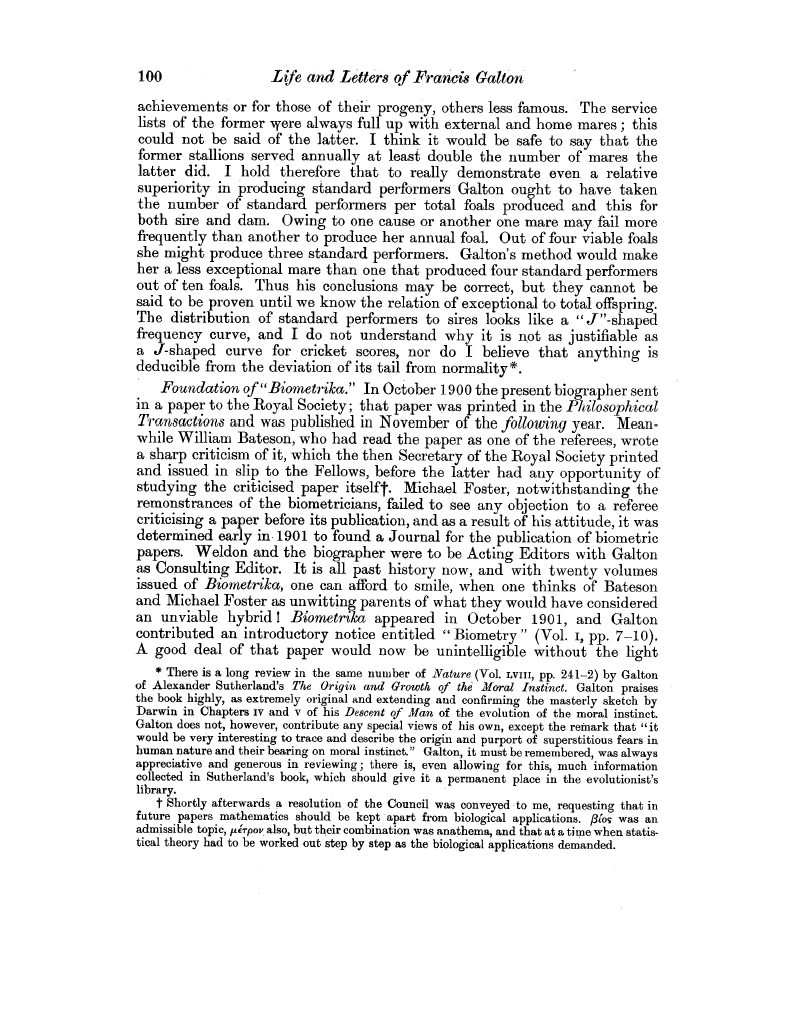| ||||||

OCR Rendition - approximate
100 Life and Letters of Francis Galton achievements or for those of their progeny, others less famous. The service lists of the former were always full up with external and home mares ; this could not be said of the latter. I think it would be safe to say that the former stallions served annually at least double the number of mares the latter did. I hold therefore that to really demonstrate even a relative superiority in producing standard performers Galton ought to have taken the number of standard performers per total foals produced and this for both sire and dam. Owing to one cause or another one mare may fail more frequently than another to produce her annual foal. Out of four viable foals she might produce three standard performers. Galton's method would make her a less exceptional mare than one that produced four standard performers out of ten foals. Thus his conclusions may be correct, but they cannot be said to be proven until we know the relation of exceptional to total offspring. The distribution of standard performers to sires looks like a "J"-shaped frequency curve, and I do not understand why it is not as justifiable as a J-shaped curve for cricket scores, nor do I believe that anything is deducible from the deviation of its tail from normality*. Foundation of "Biometrika." In October 1900 the present biographer sent in a paper to the Royal Society; that paper was printed in the Philosophical Transactions and was published in November of the following year. Meanwhile William Bateson, who had read the paper as one of the referees, wrote a sharp criticism of it, which the then Secretary of the Royal Society printed and issued in slip to the Fellows, before the latter had any opportunity of studying the criticised paper itself j-. Michael Foster, notwithstanding the remonstrances of the biometricians, failed to see any objection to a referee criticising a paper before its publication, and as a result of his attitude, it was determined early in- 1901 to found a Journal for the publication of biometric papers. Weldon and the biographer were to be Acting Editors with Galton as Consulting Editor. It is all past history now, and with twenty volumes issued of Biometrika, one can afford to smile, when one thinks of Bateson and Michael Foster as unwitting parents of what they would have considered an unviable hybrid ! Biometrika appeared in October 1901, and Galton contributed an introductory notice entitled Biometry " (Vol. i, pp. 7-10). A good deal of that paper would now be unintelligible without the light * There is a long review in the same number of Nature (Vol. LVIII, pp. 241-2) by Galton of Alexander Sutherland's The Origin and Growth of the Moral Instinct. Galton praises the book highly, as extremely original and extending and confirming the masterly sketch by Darwin in Chapters iv and v of his Descent of Man of the evolution of the moral instinct. Galton does not, however, contribute any special views of his own, except the remark that "it would be very interesting to trace and describe the origin and purport of superstitious fears in human nature and their bearing on moral instinct." Galton, it must be remembered, was always appreciative and generous in reviewing; there is, even allowing for this, much information collected in Sutherland's book, which should give it a permanent place in the evolutionist's library. t Shortly afterwards a resolution of the Council was conveyed to me, requesting that in future papers mathematics should be kept apart from biological applications. /3ios was an admissible topic, pirpov also, but their combination was anathema, and that at a time when statistical theory had to be worked out step by step as the biological applications demanded.
|